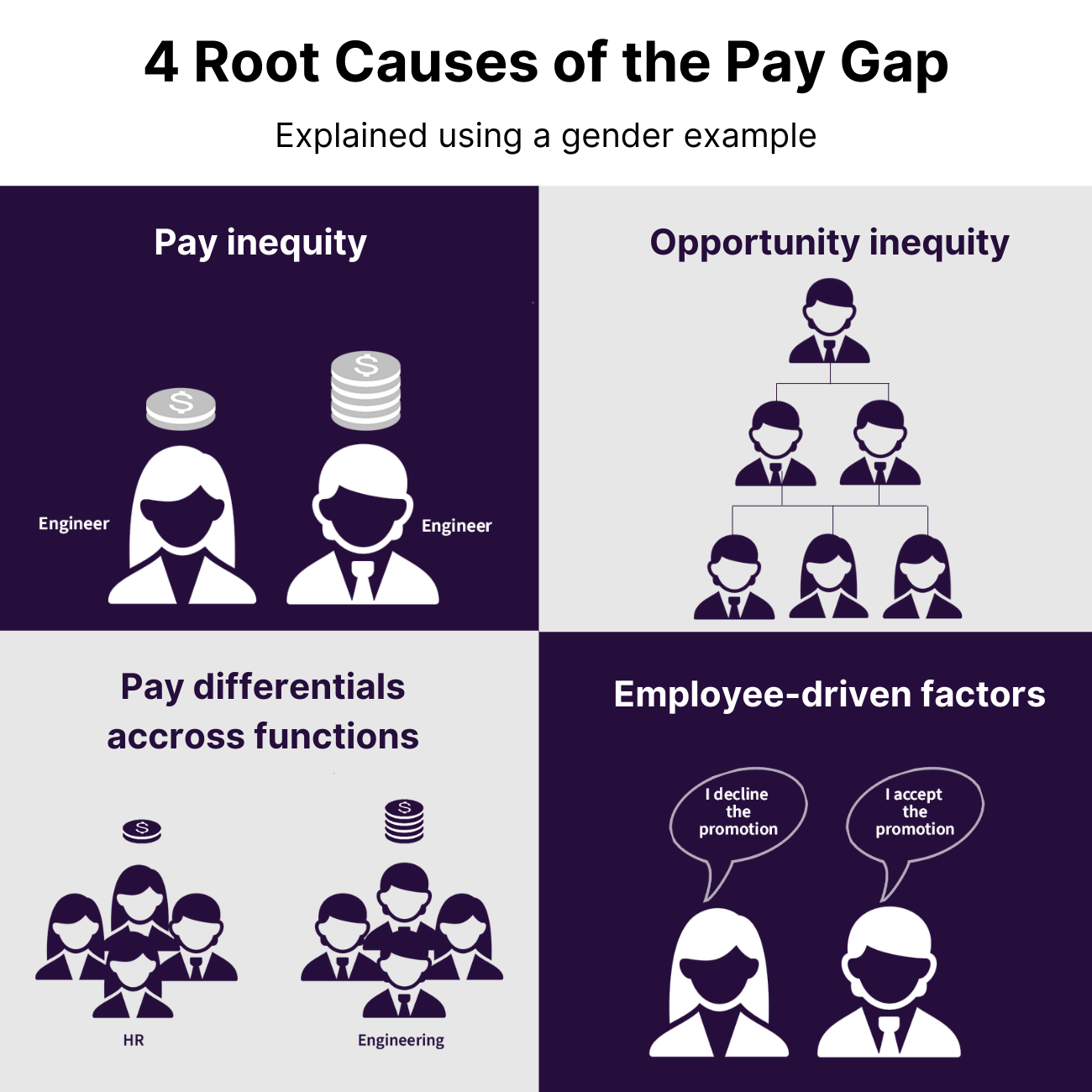We see fresh headlines all the time proclaiming that women and people of color still earn only a fraction of every dollar made by men and/or white employees. This is a reference to the “pay gap,” which is a measure of overall differences in mean or median compensation and can be analyzed for gender, race, ethnicity, or other protected characteristic categories.
Investors, employees, and the public have been increasingly vocal in demanding that companies transparently share their company’s pay gaps. Transparency is a great first step in identifying concerns, but then what?
Pay gap information is the tip of the iceberg in many cases, only telling the beginning of a story that demands further elaboration to make sense. Unless you understand what causes your pay gaps, you won’t know how to take action, ensure improvement, and understand when and why improvement is needed or not needed. So, what are the causes of the gender pay gap and the racial pay gap? Is it simply bias leading to certain groups being undervalued for their contributions? Or is it more complex? (Spoiler alert: It’s the latter.)
In this article, I’ll walk you through the four most common causes of the gender and racial pay gaps — and how your company can address each of them.
1. Pay inequity
“Pay gaps” are not the same as “pay inequities.” It’s important to know the difference and measure both. When groups of employees who do substantially similar work are paid differently due to their gender, race, or ethnicity, that’s a pay inequity. When those inequities are not completely accounted for by differences due to neutral, job-related policies or practices, the pay inequities often require more attention.
If left unaddressed, pay inequity issues may lead to serious legal and brand risks. Not only do pay disparities negatively impact employees in their current roles but also inequities often compound over time, creating even larger disparities in wealth accumulation.
Pay inequity often isn’t the biggest driver of a company’s pay gap — and, in fact, some organizations can solve their pay inequity issues but may still have a persistent “all up” pay gap (more on that issue below). But, addressing this is where many organizations start in their efforts to close the pay gap and simultaneously address other important concerns.
That’s because pay inequity is entirely within the company’s control and is relatively easy to solve, assuming the company has the budget to increase compensation for underpaid employees. Plus, new pay equity analysis technology is giving compensation teams even more control over pay equity so they can incorporate fair pay into every employment decision.
Related content: Learn about the new standards for fair pay and how your organization can modernize your pay equity strategy here.
2. Opportunity inequity
Another cause of the pay gap is unequal access to opportunities. When underrepresented groups of employees don’t have equal access to jobs, promotions, opportunities to collaborate on certain projects, and other forms of advancement, it hinders their chances of moving into higher-paying roles.
This leaves companies with a lack of representation at the highest levels of the business and also has a long-term negative impact on employees’ earning potential. This is exactly the situation referenced above; it’s how an organization that’s addressed the pay inequity problem could still have a persistent pay gap issue.
Similar to pay equity, opportunity equity is also largely within an organization’s control. To improve opportunity equity, companies must evaluate their recruiting, hiring, onboarding, and promotion policies and ensure they are consistently enforced for all employees and candidates.
The good news is that solving this problem is increasingly within reach. Emerging technology is helping companies:
- Analyze their current representation across departments and levels
- Determine what their representation should look like based on available talent
- Take the right steps to achieve optimal representation goals on an appropriate timeline
3. Pay differentials across functions
Pay differentials among different functions are another contributing factor to the pay gap. For example, IT employees (traditionally male-dominated) may be paid more than HR employees (traditionally female). While function-based pay differentials are typically informed by talent market dynamics, company policy does play a role.
When there are significant gender imbalances across functions, it’s useful to evaluate whether and why the organization ascribes appropriate value for the outputs of the work performed. Question whether “gendered jobs” are valued differently and if those justifications are valid — not from the perspective of what the work is worth on the external labor market but internally, relative to other functional outputs.
One way companies can start to de-gender jobs with persistent imbalances is by evaluating how they’re recruiting employees into the various functions. Are you using inclusive language in job descriptions? Are you promoting the job opening through job boards and organizations that have access to diverse talent pools? Does your organization offer sufficiently robust resources to ensure that there are opportunities to move laterally or upskill to new roles? These may seem like small adjustments, but they can have a big impact on diversity in your organization over time.
4. Employee-driven factors
There are some employee-driven factors that contribute to the pay gap (so called “labor supply effects”) — and while these aren’t fully within a company’s control, there are things you can do to address the problem.
For example, in some cases, women may be offered jobs or promotions at the same rates as men. But women may self-select out of offered opportunities (i.e., declining promotions) at a higher rate than men. Many companies observed this happening due to the COVID-19 pandemic. We saw record numbers of women and people of color leaving the workplace at higher rates than other groups, or otherwise bearing a disproportionate share of the increased burdens of kids being home all day for “zoom schooling” and related changes.
Additionally, some companies may draw in more men or white people due to how their industry or company brand is perceived. In this scenario, it’s important to partner with corporate branding teams in working to change these public perceptions. That is not an easy task, but it is important if this perception is going to change.
If your organization begins to see trends like this, it’s critical to try and understand why. By digging further into what’s driving the pattern, you may find opportunities to build in more inclusive policies, such as parental leave or on-site daycare, to address those issues.

How to start addressing your company’s pay gap
So, what are the causes of the gender and racial pay gaps at your company? To find out, you’ll first have to quantify the pay gap itself, and then analyze its root causes. Today, pay equity analysis solutions and other equity technologies make these types of analysis fast and easy.
Already know you have a pay equity problem? Find out how to modernize your strategy by requesting a demo.


